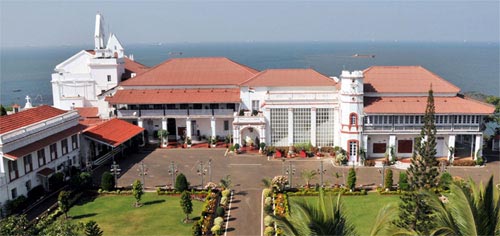Raj Bhavan

Information on Raj Bhavan (Goa) - History & Architecture
Situated in the south point of river Mandovi and at the great end of Arabian Sea, Raj Bhavan is one of the monuments of historical and architectural importance of Goa. Raj Bhavan is known as various other names such as Cabo Palace or Cabo Raj Niwas which was created in 1540 AD. Traditionally, throughout the Portuguese command, Raj Bhavan was regarded as the authorised house of the governor general. At later phase it has become the authorised house of lieutenant governor of the 'Union Territory of Goa'.
Raj Bhavan Architecture
It is a two storeyed construction where the ground floor comprises office compartment, the house of the governor and several guests' rooms. The first floor of the fort comprises Darbar hall, seminar hall, banquet hall, the primary kitchen and some visitor rooms. The Darbar hall and banquet hall of Raj Bhavan are designed with traditional and vintage materials viz. Chinese ceramic arts and unconventional glass among others. The Darbar hall of the fort is the authorised reception centre which is used for imprecation formalities and for other official events. On the other hand, the banquet hall of Raj Bhavan possesses space for about 30 persons. The office of the governor along with the administrators and employees are positioned in a distinct section of the ground floor.
Before the construction of Raj Bhavan, a small sanctuary was established at the end of the building. The sanctuary was dedicated to a woman named Nossa Senhora. Afterwards, this sanctuary caught the attention of a Portuguese viceroy, named D. Matias. He decided to reconstruct the sanctuary and to create a monastery alongside it. The foundation of the monastery was placed in the year 1594 AD and it took around six months to complete it. In later phase, the monastery was known as Raj Bhavan.
Raj Bhavan History
The history of Raj Bhavan is it's complexly related with the strategic location. During the period of 1540 to 1542, the governor of Goa attempted to create a fort in the strategic location of present Raj Bhavan in order to observe as well as regulate the entrance of vessels to the Mandovi and Zuari River. In the early 1541, a sanctuary named 'Our Lady of the Cape' was created, in order to develop series of sanctuaries for inmates on the edge of Tiswadi Island. The first stone of sanctuary was laid in the year 1594. Initially, there was only ground floor and at later phase, the second storey was added to the sanctuary. There was only four inmates in the initial phase and by 1633, the number of inmates became 15. Antonio Bocarro who had seen 15 friars in the sanctuary provided comprehensive explanation for further development of the fort. However, at the initial phase, no soldier resided in the fort, except the watchmen. Still, improvement to the building of the fort continued and by 1733, the fort has become a developed castle.
Although created by Portuguese, Raj Bhavan was better utilised by British people. During the British sovereignty, they created hospitals and garrisons among other structures to the fort. After the departure of British people from the fort in 1813, the governor general took special curiosity in the fort and made certain developments. In the year 1844, the fort was given to the bishop of Goa, who transformed the fort into a residential place. Later in 1866, the Portuguese government again took authority of the fort and the properties were taken by the governor for residential purpose. The prison cell of the fort was transformed into large halls and eventually it became Raj Bhavan.
Raj Bhavan Tourism Importance
The present Raj Bhavan is the official name provided to the house of governors. It is regarded as one of the premium homes for Indian governors and certainly the oldest ones which makes it an important place for visit. Furthermore, the palace has significant history regarding its origin which is about four hundred years old. As a result, it is counted as quite an interesting place for travellers to learn about the tradition of the palace. Besides, its impressive location along with the decoration of rooms can also attract the travellers towards visiting it.
- Andaman Nicobar Monuments
- Andhra Pradesh Monuments
- Assam Monuments
- Bihar Monuments
- Chhattisgarh Monuments
- New Delhi Monuments
- Goa Monuments
- Gujarat Monuments
- Haryana Monuments
- Himachal Pradesh Monuments
- Jammu and Kashmir Monuments
- Karnataka Monuments
- Kerala Monuments
- Madhya Pradesh Monuments
- Maharashtra Monuments
- Odisha Monuments
- Punjab Monuments
- Rajasthan Monuments
- Tamil Nadu Monuments
- Telangana Monuments
- Uttar Pradesh Monuments
- West Bengal Monuments